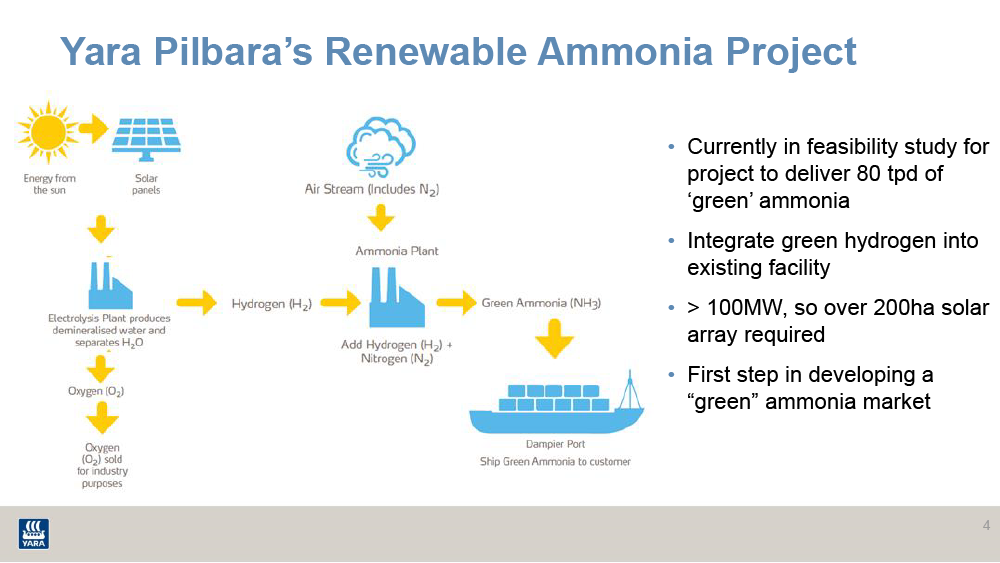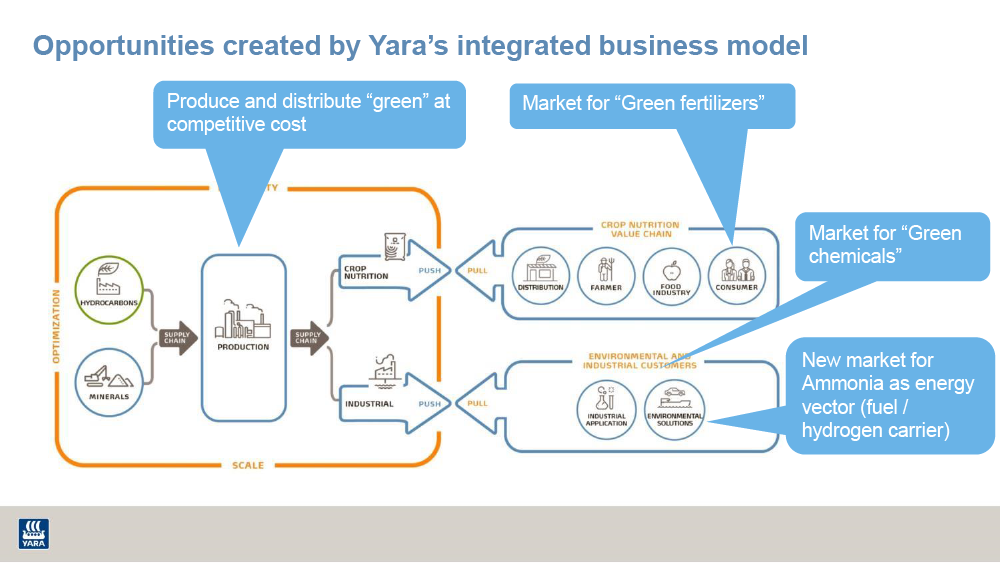Ammonia plant revamp to decarbonize: Yara Pilbara
By Trevor Brown on February 15, 2019
This week, Yara announced major progress toward producing “green ammonia” at its plant in Pilbara, Australia. Its new partner in this project is ENGIE, the global energy and services group, which last year made a major commitment to developing large-scale renewable hydrogen projects.

I first reported Yara’s plans for a solar ammonia demonstration at its Pilbara plant in September 2017. This week’s announcement means that the Pilbara project has moved to the next feasibility phase. However, major elements of the project have already been designed and built: during last year’s scheduled turnaround for plant maintenance, the hydrogen piping tie-in was completed – meaning that the Haber-Bosch unit is ready to receive hydrogen directly, as soon as an electrolyzer has been built to supply it with renewable feedstock.
It was only two weeks ago that I wrote about Yara’s implementation of a project to reduce emissions at Sluiskil in the Netherlands, its largest ammonia plant. That site revamp involved the tie-in of a 12-mile pipeline to deliver byproduct hydrogen from Dow’s nearby ethylene cracker. This created a hybrid ammonia plant that combined on-site hydrogen production (using conventional natural gas-fed SMR units) with a direct hydrogen feedstock supply.
The decarbonization potential at Sluiskil is small, so far: the pipeline carrying byproduct hydrogen currently has a capacity of only 4,000 tons of hydrogen, but feeds a production site with a capacity of over 1.5 million tons of ammonia, reducing emissions by less than 1%. I’ve previously written about the decarbonization potential of byproduct hydrogen, which is minor compared to renewable hydrogen. Nonetheless, the engineering and infrastructure now on site have the potential to support far greater integration of hydrogen in the future.

The solar ammonia demonstration project at Pilbara is also starting small. The planned 200 hectare solar array will have a 100 MW capacity, allowing Yara to produce 80 tons per day of green ammonia, a small fraction of the site’s annual capacity of 840,000 tons of fossil ammonia.
[Update: 02/18/2019: In an interview with local media, plant manager Chris Rijksen added that the electrolyzer unit would have a capacity of 50-60 MW, and could be in operation by 2021 at the earliest.]
The Sluiskil project uses byproduct hydrogen and the Pilbara will use renewable hydrogen. Inside the ammonia plant boundary limits, however, the physical difference between the Sluiskil and Pilbara projects is simply that, in Australia, there is no pipeline delivering pure hydrogen feedstock – yet.

For both projects, the tie-in of hydrogen piping means that the infrastructure is in place for greater decarbonization in the future.
This is Yara’s hybridization strategy, by which it aims to decarbonize its existing assets by increments, gradually increasing the proportion of renewable feedstock and steadily reducing its consumption of fossil fuels.
The goal of the feasibility study is to convert the Pilbara ammonia plant from one that relies completely on natural gas for its hydrogen to one where a significant share of its hydrogen comes from renewable power. Reaching the goal will significantly reduce the plant’s CO2 emissions.
Yara announcement, Yara and ENGIE to test green hydrogen technology in fertilizer production, 02/13/2019
Since I first wrote about Yara’s solar ammonia demonstration, the most frequent question I’ve received has been: how can an intermittent power source like solar drive a constant operation like the Haber-Bosch process?
This is where Yara’s new partner, ENGIE, excels.
Renewable sources like solar or wind are intermittent. Clouds move in and winds die down. ENGIE is investing in clean hydrogen in the belief that it is likely to become a key component in clean energy networks because it can store energy in large quantities, over long periods of time and across great distances. Hydrogen can make the sun shine at night.
Reducing the costs of producing, storing, transporting and deploying hydrogen is crucial. Setting out to design, build and operate real, at-scale, integrated projects like the YARA Pilbara plant allows for a real-world, real-time analysis of costs and processes.
ENGIE announcement, ENGIE and YARA take green hydrogen into the factory, 02/12/2019
ENGIE is one of the European companies that, in 2018, despite being built on a history of fossil fuel exploitation, made a corporate commitment to systemic decarbonization. In Norway, Statoil became Equinor. In Denmark, MAN Turbo & Diesel became MAN Energy Solutions. In France, the ENGIE Group (over 150,000 employees in 70 countries, with 2017 revenues of EUR 65 billion) declared that “we take up major global challenges such as the fight against global warming.”
ENGIE already has a presence at every link in the hydrogen value chain, from its production using energy from renewable sources … right through to its end-user applications in mobility, industrial processes and Power-to-Gas solutions …
But the challenge of hydrogen development lies in having large-scale renewable hydrogen production technologies in place, and encouraging stakeholders to invest in technologies that enable the use of renewable hydrogen.
So at the start of 2018, ENGIE set up a new global business unit dedicated solely to renewable hydrogen and headed up by Michèle Azalbert to act as a catalyst for major projects and bring together all the relevant skills and expertise within the Group as the basis for developing and offering turnkey solutions. ENGIE targets every link in the value chain, from renewable hydrogen production to storage and distribution.
ENGIE announcement, ENGIE backs hydrogen, 06/12/2018
Supporting its work with Yara in the Pilbara, ENGIE already has 1,800 employees in more than 30 locations across Australia and New Zealand, where its business areas include solar farm development; power generation from wind and natural gas; sales of electricity, gas, and energy storage; and a broad range of “multi-technical services,” including efficiency, security, and “solutions for cities.”

So far, ENGIE’s corporate vision for renewable hydrogen does not explicitly include ammonia, although ammonia represents over 50% of today’s total global hydrogen consumption. Collaboration with Yara on the Pilbara project may change this view.
As regards renewable hydrogen, ENGIE believes that “parity with grey [fossil] resources is achievable,” through four strands of market development:
- “Massive” green hydrogen production from renewable energy sources (RES);
- Local consumption across numerous markets (“multi-usage”);
- Green energy exports, using a chemical hydrogen carrier, from regions with excellent renewable energy (like Australia) to regions with limited renewables;
- Global trade and consumption across numerous markets (“multi-usage”).
Ammonia producers will note that, in point three above, for energy exports, ENGIE leaves the door wide open to the acceptance of ammonia as perhaps the most cost-effective method of storing and transporting hydrogen for long durations and across long distances.

Both ENGIE’s Azalbert and Yara’s Rijksen spoke at the Renewable Hydrogen Conference organized in August 2018 by the Government of Western Australia (WA). As a result of that conference, WA established the Renewable Hydrogen Council “to provide strategic advice and leadership” on the establishment of a renewable hydrogen industry in WA.
While companies like Yara and ENGIE can drive down the technology costs of green ammonia and support its market development, government support is crucial, especially in helping to close the economic gap for early projects, until renewable hydrogen hits cost parity with fossil hydrogen.
Among the other objectives of WA’s new Renewable Hydrogen Council, it aims to provide advice on:
- Identification of international and domestic market opportunities, structures and supply chains;
- Potential (if any) market failure, regulatory impediments affecting development of the industry in WA, and provide potential solutions;
- Opportunities and barriers to assist existing energy industries to transition to a renewable hydrogen future; and
- Any appropriate facilitation that could be provided by the WA Government.
Government of Western Australia, Renewable Hydrogen Council, accessed February 2019
You can also read the full article at AmmoniaIndustry.com.